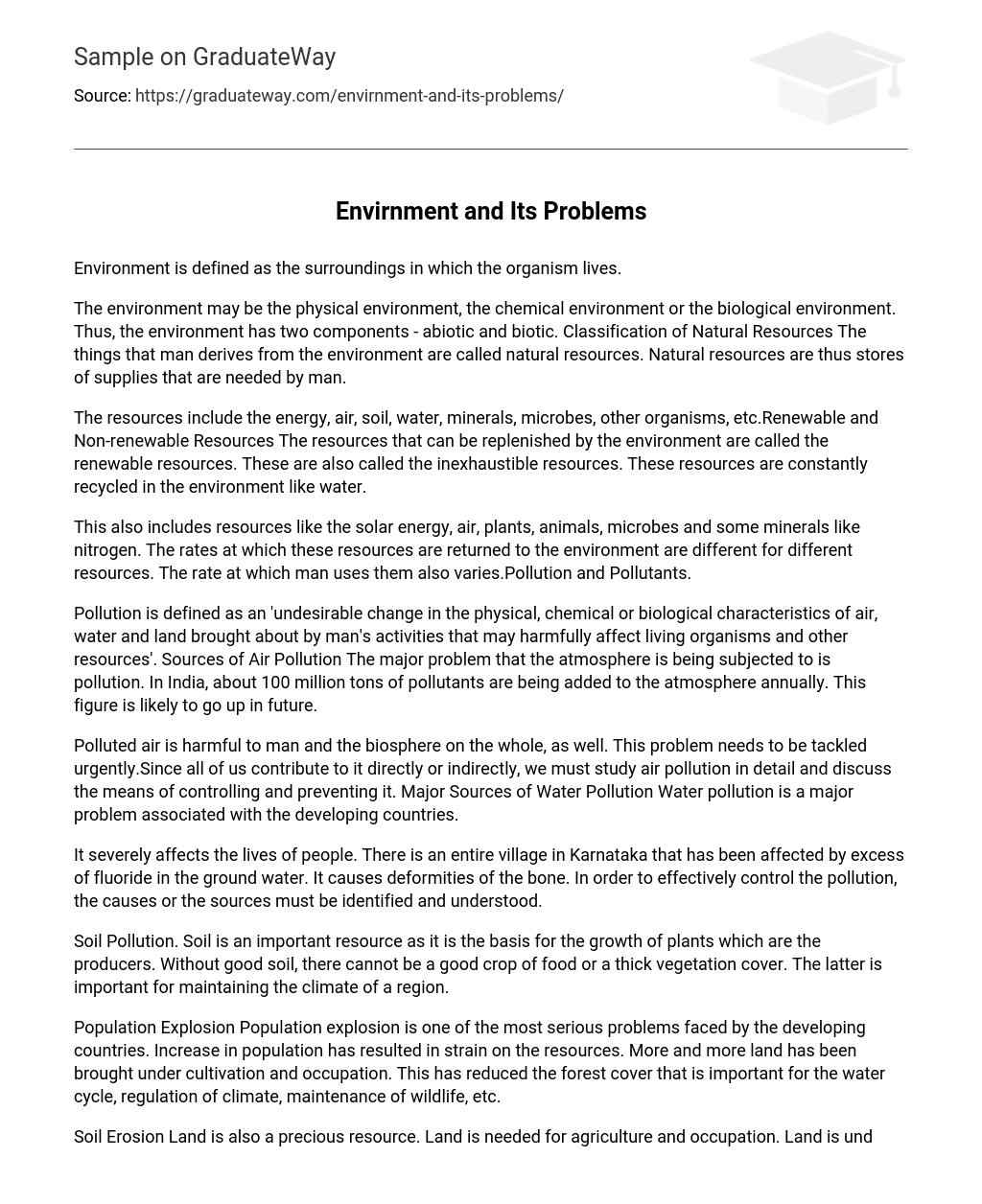Environment is defined as the surroundings in which the organism lives.
The environment may be the physical environment, the chemical environment or the biological environment. Thus, the environment has two components – abiotic and biotic. Classification of Natural Resources The things that man derives from the environment are called natural resources. Natural resources are thus stores of supplies that are needed by man.
The resources include the energy, air, soil, water, minerals, microbes, other organisms, etc.Renewable and Non-renewable Resources The resources that can be replenished by the environment are called the renewable resources. These are also called the inexhaustible resources. These resources are constantly recycled in the environment like water.
This also includes resources like the solar energy, air, plants, animals, microbes and some minerals like nitrogen. The rates at which these resources are returned to the environment are different for different resources. The rate at which man uses them also varies.Pollution and Pollutants.
Pollution is defined as an ‘undesirable change in the physical, chemical or biological characteristics of air, water and land brought about by man’s activities that may harmfully affect living organisms and other resources’. Sources of Air Pollution The major problem that the atmosphere is being subjected to is pollution. In India, about 100 million tons of pollutants are being added to the atmosphere annually. This figure is likely to go up in future.
Polluted air is harmful to man and the biosphere on the whole, as well. This problem needs to be tackled urgently.Since all of us contribute to it directly or indirectly, we must study air pollution in detail and discuss the means of controlling and preventing it. Major Sources of Water Pollution Water pollution is a major problem associated with the developing countries.
It severely affects the lives of people. There is an entire village in Karnataka that has been affected by excess of fluoride in the ground water. It causes deformities of the bone. In order to effectively control the pollution, the causes or the sources must be identified and understood.
Soil Pollution. Soil is an important resource as it is the basis for the growth of plants which are the producers. Without good soil, there cannot be a good crop of food or a thick vegetation cover. The latter is important for maintaining the climate of a region.
Population Explosion Population explosion is one of the most serious problems faced by the developing countries. Increase in population has resulted in strain on the resources. More and more land has been brought under cultivation and occupation. This has reduced the forest cover that is important for the water cycle, regulation of climate, maintenance of wildlife, etc.
Soil Erosion Land is also a precious resource. Land is needed for agriculture and occupation. Land is under pressure due to increasing population. Land for agriculture has to be fertile in order to be able to support a good crop.
The fertility of land lies in the quality of the soil. Global Warming The addition of certain pollutants like the carbon dioxide gases increases the temperature of the earth. These gases remain close to the surface of earth, forming an insulating layer. The surface becomes hot due to the solar radiations.
Accumulation of Wastes. Accumulation of wastes due to its improper disposal is a major problem in our country. The recent Surat plague epidemic is an indication. Population in India has been growing at the rate of 1.
7%. With this increase, there has also been an increase in the amount of wastes being produced especially in the cities. Recycling of Waste It is very important to have good and effective waste management techniques as the waste generated cannot be reduced easily. With increasing population, wastes generated are only going to increase.
Loss of Wildlife. Wildlife includes the flora and fauna present in the forests. Flora is the collections of plants and fauna, the collection of animals. Precious plants and animals are becoming extinct or endangered as a result of clearing of the forests.
The forests are home to many precious species of plants and animals. Conservation of Wildlife Creating national parks and wildlife sanctuaries for safe breeding of the endangered and other species. National parks are areas that are permanently reserved for conservation of natural resources. For example, Kanha national park known for tiger, leopards, etc.
Ecological Balance and Sustainable Development The environment in which the man and other organisms live is called the biosphere. The biosphere is made up of different regions that have different types of flora (plants) and fauna (animals). The types of organisms in an area are determined by various factors such as the climate, temperature, rainfall, etc. Interrelationship of Population, Environment and Development As mentioned earlier man’s intervention is causing drastic changes in the environmental systems of earth and disturbing its ecological balance.
This disturbance gets compounded with the problem of population explosion in the world especially the developing countries. Conservation and Protection of the Environment Conservation is defined as judicious use to avoid wastage of materials and degradation of environment. Conservation of environment involves the conservation of the natural resources. The non-renewable resources have to be conserved as they cannot be replenished.
The reserves of the resources such as fossil fuels are limited and man is heavily dependent on these resources for his day to day needs.The renewable resources too have to be judiciously used. Though they are replenished, they are subjected to a lot of pollution that renders them useless. Environmental Laws One of the fundamental rights, according to the Indian constitution, is the Right to Life that has been interpreted as the Right to Healthy Environment.
It is an adequate tool for ensuring sustainable development. Summary The abiotic environment includes the air (atmosphere), water (hydrosphere) and land (lithosphere). The biotic environment includes the plants, animals and the microbes.





